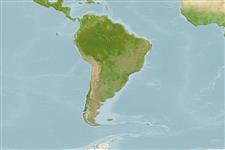Ikan bertulang rawan (sharks and rays) >
Myliobatiformes (Stingrays) >
Dasyatidae (Stingrays) > Dasyatinae
Etymology: marianae: Named for Mariana R. Oliveria, daughter of Otto B.F. Gadig..
Environment: milieu / climate zone / depth range / distribution range
Ekologi
laut dasar (demersal); kisaran kedalaman 2 - 15 m (Ref. 36974). Tropical; 0°S - 19°S, 38°W - 45°W (Ref. 36974)
Southwest Atlantic: along the northeastern Brazilian coast, from the state of Maranhão to southern Bahia.
Size / Weight / umur
Maturity: Lm ? range ? - ? cm
Max length : 40.0 cm WD jantan/; (Ref. 36974)
deskripsi pendek
Morfologi | Morfometrik
This medium-sized species of Dasyatis is distinguished by the following characters: horizontal diameter of eye nearly equal to interorbital width and spiracle length; its tail is relatively short, less than two times disk width, distally filiform, with dorsal and ventral finfolds, ending approximately on same vertical line; height of dorsal finfold 1.5-2 in height of ventral finfold; the dorsal surface of disc is yellowish brown, with dark blotch between spiracles and two pairs of dark scapular and precaudal blotches; margins of disc and pelvic fins are blue dorsally; the ventral surface of disc white, with two symmetrical pairs of dark markings in adults (Ref. 36974).
Apparently associated with coral or sandstone reefs of the northeastern Brazilian continental shelf. Two female specimens were collected from the stomach of Rachycentron canadum (Ref. 36974). Juveniles also occurred in sandy beaches and estuaries. Ovoviviparous (Ref. 50449).
Exhibit ovoviparity (aplacental viviparity), with embryos feeding initially on yolk, then receiving additional nourishment from the mother by indirect absorption of uterine fluid enriched with mucus, fat or protein through specialised structures (Ref. 50449). Distinct pairing with embrace (Ref. 205). A gravid female aborted one fully formed embryo (Ref. 36974).
Gomes, U.L., R.S. Rosa and O.B.F. Gadig, 2000. Dasyatis marianae sp. n.: a new species of stingray (Chondrichthyes: Dasyatidae) from the southwestern Atlantic. Copeia 2000(2):510-515. (Ref. 36974)
Status IUCN Red List (Ref. 130435)
ancaman kepada manusia
Harmless
penggunaan manusia
informasi lanjut
AcuanBudidaya airprofil budidaya airStrainGenetikaElectrophoresesDiturunkanPenyakit-penyakitPengolahanNutrientsMass conversion
mitraGambarStamps, Coins Misc.Suara-suaraCiguateraKecepatanTipe renangArea insangOtolithsOtakPenglihatan / visi
Alat, peralatan
laporan khas
muat turun XML
Sumber internet
Estimates based on models
Preferred temperature (Ref.
123201): 27 - 27.9, mean 27.4 °C (based on 44 cells).
Phylogenetic diversity index (Ref.
82804): PD
50 = 0.5039 [Uniqueness, from 0.5 = low to 2.0 = high].
Bayesian length-weight: a=0.01175 (0.00715 - 0.01930), b=3.10 (2.96 - 3.24), in cm total length, based on LWR estimates for this species & (Sub)family-body (Ref.
93245).
Trophic level (Ref.
69278): 3.5 ±0.5 se; based on size and trophs of closest relatives
Daya lenting (Ref.
120179): sangat rendah, Waktu penggandaan populasi minimum lebih dari 14 tahun (Fec=2).
Fishing Vulnerability (Ref.
59153): Very high vulnerability (90 of 100).
